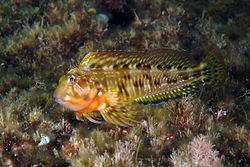| Scartella | |
|---|---|
 | |
| Scartella cristata | |
| Scientific classification | |
| Kingdom: | Animalia |
| Phylum: | Chordata |
| Class: | Actinopterygii |
| Order: | Blenniiformes |
| Family: | Blenniidae |
| Subfamily: | Salarinae |
| Genus: | Scartella D. S. Jordan, 1886 |
| Type species | |
| Blennius microstomus Poey, 1860 | |
| Species | |
See below. | |
Scartella is a genus of combtooth blennies found in the Atlantic and Indian oceans. [1]